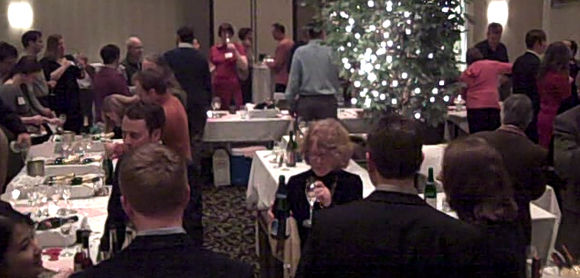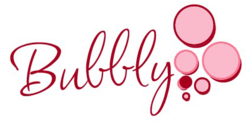
By Tom Mansell, Science Editor
On Saturday night in Watkins Glen, the corks were popping and the bubbly was flowing.
 Bubbly, a unique event organized by Finger Lakes Wine Country, featured 16 sparkling wine producers from around the Finger Lakes pouring about 28 different sparklers. It also included the up-and-coming Finger Lakes Distilling, which brought cassis and raspberry liqueurs for tasting and mixing with sparkling to create Finger Lakes Kirs Royales. The event took place in the ballroom of the plush Watkins Glen Harbor Hotel along the shore of Seneca Lake.
Bubbly, a unique event organized by Finger Lakes Wine Country, featured 16 sparkling wine producers from around the Finger Lakes pouring about 28 different sparklers. It also included the up-and-coming Finger Lakes Distilling, which brought cassis and raspberry liqueurs for tasting and mixing with sparkling to create Finger Lakes Kirs Royales. The event took place in the ballroom of the plush Watkins Glen Harbor Hotel along the shore of Seneca Lake.
Food offerings included lots of rich creamy goodies (e.g., tortellini alfredo) to pair with the refreshing acid of the wines, and of course, chocolate-covered strawberries.
The atmosphere was casual and congenial and featured many winemakers and winery owners pouring their own wines (and more importantly, answering technical questions from yours truly). It was a great opportunity for one-stop tasting of many of the sparkling wines that the region has to offer.
But it wasn't all champagne wishes and caviar dreams; I was there on business. In sampling the wines and talking to the winery staff I took home a few ideas about the current state of Finger Lakes fizz.
The Finger Lakes region is making many different styles of sparkling wine.
From the fruit-forward short-aged wines to the yeasty, toasted marshmallow notes that come with long aging on the yeast lees, producers were pouring a diverse array of flavors. As Evan Dawson mentioned last week, some producers stick with traditional Champagne grapes: pinot noir, chardonnay and pinot meunier, while others have branched out.
I enjoyed the light, fruity profiles of Lucas Vineyards' Extra Dry (NV), made with Cayuga White, and Atwater Estate's 2006 Cuvee Brut , which blends Chardonnay, Riesling, and Gewürztraminer (though the traditional varietal character of Gewürztraminer was not immediately present, possibly due to early harvest of the grapes for sparkling).
Some of the longer tirage (aging on lees) wines of the evening were real standouts for me, including Lamoreaux Landing 2006 Blanc de Blanc (3 years tirage), Château Frank 1999 Prestige Cuvée (more than 5 years tirage, and, incidentally, NYCR Finger Lakes Sparkling Wine of the Year), and Red Tail Ridge 2006 Blanc de Noirs (1 year tirage, but 3 years in bottle). These tended to show more complex flavors like strawberry, and the toasty aromas characteristic of yeast autolysis.
In discussing with the winemakers, I found out that almost every method of sparkling wine production was represented. Many claimed "méthode champenoise", even if it didn't appear on the label. That is, second fermentation in bottle, riddling (periodically turning and inclining the bottles) over the tirage duration, then disgorging and perhaps adding a dosage of sweetness. This method, also called the traditional method, is also very labor-intensive as in most cases riddling is done by hand.
Larger producers like Pleasant Valley use the Charmat method (secondy fermentation in tanks, then bottling under pressure). I even heard the transfer method (fermentation in bottle, then disgorging into a tank, filtering, and re-bottling under pressure) mentioned. These methods may be cost-effective, but they require equipment that is only economically feasible on much larger scale.
Lakewood Vineyards has an interesting concept in its Candeo, a "Prosecco-style" white that is force-carbonated and sealed with a crown cap. This greatly reduces the cost and labor associated with production.
Small producers are getting in the game by sharing equipment at bigger facilities.
Some obstacles to sparkling wine production in the Finger Lakes have been discussed on this blog previously, including the time and labor required, the capital investment (both the initial cost for equipment and the capital tied up in laying down wine for 1-3 years before release).
In addition, the Federal Tax and Trade Bureau taxes sparkling wines at a rate over three times higher than that of standard still wine. Given these hurdles, it might seem difficult for smaller producers to make any sparkling at all. Cooperation, here, seems to be the name of the game.
Heart & Hands Wine Company, which produced just 45 cases of its knockout Brut Rosé 2008, uses equipment at Glenora Winery for the disgorging process. According to Steve DiFrancesco, winemaker at Glenora, some of their production spills over (so to speak) to the facilities at Pleasant Valley when Glenora is overwhelmed.
Lakewood's forced-carbonation experiment takes place using equipment at Bellwether Cidery on Cayuga Lake.
Sharing equipment benefits both parties, since borrowers can make use of expensive machinery for less than the high initial cost required and the owners can recoup some of their investment by loaning out equipment. A similar model is in place for some wineries that own other big-ticket items like mechanical harvesters.
Why are we still using "Champagne"?
It was an interesting moment when I realized that Château Frank and Pleasant Valley were pouring right next to each other at Bubbly. The histories of these two producers are quite different, but they do have one thing in common: both of their sparkling wine labels carry the word "Champagne."
For years, large producers have used geographical indicators like Chablis, Burgundy, etc., to create an association of their product with the fine quality wines of Europe, regardless of the fact that pinot noir and chardonnay might be substituted with Concord and Thompson Seedless.
Even recently, some Finger Lakes bottles have carried the label "Johannisberg Riesling."
To the uneducated consumer, these words are familiar and connote "fine wine," but to consumers who know even a little bit about wine, they can be patronizing, if not downright insulting. The surprising part here is that while the presence of names like this conjure in me the image of jug wines and low-quality brands, Château Frank produces excellent sparkling wine. A producer of this quality doesn't need to rely on the term.
The fact that some terms like this may be "grandfathered" in since producers have been using them for so long is irrelevant. If we want to establish ourselves as a world-class sparkling region on
our own merit, then use of these geographical indicators is inadvisable and unnecessary.
Recently, Long Island wine producers signed the Joint Declaration to Protect Wine Place & Origin, agreeing to "work together to bring the necessary awareness and advocacy to bear to ensure these names are protected and respected." Perhaps it is in the best interest of quality Finger Lakes producers to do the same.
Overall, my Bubbly experience gave me an opportunity to look at a variety of sparklers from across the region. I love sparkling and it will be great when an event like this draws 30 or 40 sparkling producers. On paper, the Finger Lakes has an ideal climate for sparkling wine production, but production is hindered by economic hurdles.
To those producers bold enough to make some of the delicious wines I had at Bubbly, cheers.
